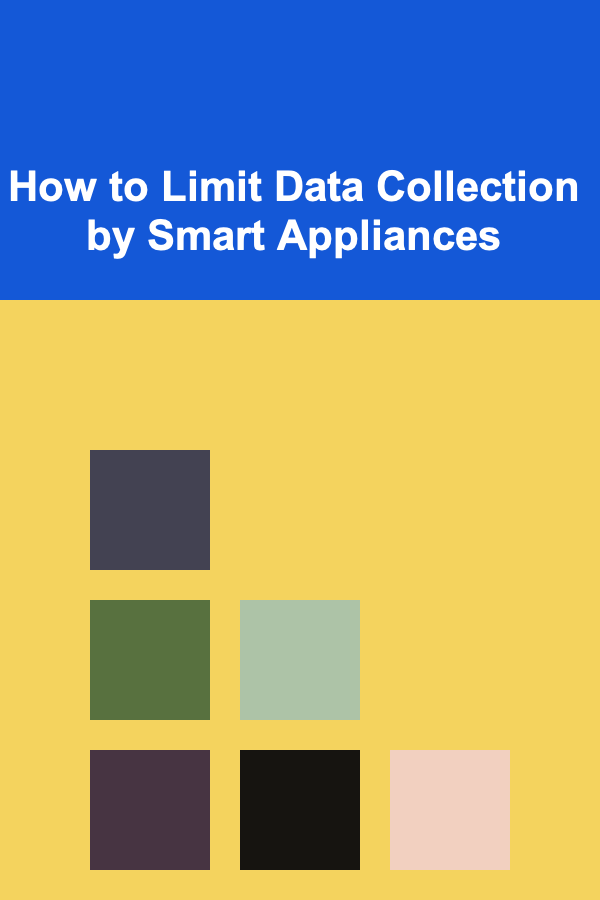
How to Limit Data Collection by Smart Appliances
ebook include PDF & Audio bundle (Micro Guide)
$12.99$6.99
Limited Time Offer! Order within the next:

The rise of the Internet of Things (IoT) has led to a significant surge in the popularity of smart appliances. From smart refrigerators to voice-controlled assistants and even smart thermostats, these devices have made their way into millions of households, promising convenience, efficiency, and personalization. However, with their increasing integration into daily life, concerns over privacy and data security have also emerged.
Smart appliances often collect a wealth of personal data to improve their functionality, from usage patterns to personal preferences. While this data is integral to the optimal performance of these devices, it can also lead to privacy risks if not properly managed. For consumers, it's essential to understand how to limit data collection by these devices and safeguard personal information. This article delves deep into strategies for minimizing data collection by smart appliances and ensuring that privacy remains a top priority.
The Growing Concerns with Smart Appliances
Smart appliances are designed to collect, process, and sometimes share data to enhance user experience. This data can range from simple usage metrics to sensitive personal information. For instance, a smart refrigerator can track the food you store and notify you when items are running low. A smart thermostat learns your temperature preferences and adjusts the climate in your home accordingly. While these features make daily life more convenient, they also mean that your personal habits and behaviors are being constantly monitored.
Potential Privacy Risks
- Excessive Data Collection: Many smart appliances collect more data than necessary for their primary functions. For example, some smart devices may gather audio or video recordings, location data, or even information about your social interactions, which is not essential for the appliance's intended purpose.
- Data Sharing and Third-Party Access: Data collected by smart appliances is often shared with third parties, including manufacturers, service providers, or advertisers. This raises concerns about the extent to which personal data is being shared and who has access to it.
- Security Vulnerabilities: Smart appliances are connected to the internet, which makes them susceptible to hacking. If these devices are compromised, they can become gateways for cybercriminals to gain access to personal information, home networks, or even control of the appliance itself.
- Lack of Transparency: Many smart appliances do not clearly inform users about what data is being collected and how it is being used. The terms of service and privacy policies can often be long, convoluted, and difficult for average users to comprehend.
- Unauthorized Data Retention: Some smart appliances retain data for extended periods, even if the user has not consented to such retention. This data can be sold or used for marketing purposes without the user's explicit knowledge or consent.
How to Limit Data Collection by Smart Appliances
While it may not be possible to completely eliminate data collection, there are several effective strategies that can help minimize the amount of personal data collected by smart appliances. Below are some of the most practical steps consumers can take to protect their privacy.
1. Understand Privacy Settings
Before using any smart appliance, it is crucial to understand its privacy settings. Many smart devices come with built-in options to limit data collection. These settings can often be accessed through the appliance's companion app or its settings menu.
- Disable Unnecessary Features: Review the features of the appliance and turn off any functionality that is not required. For instance, you might not need voice recognition or personalized notifications for a smart refrigerator or thermostat.
- Limit Data Sharing: Many smart appliances have options to limit or completely disable data sharing with third parties. Always opt for the most restrictive setting when it comes to sharing data with the appliance's manufacturer or other entities.
- Adjust Data Retention: Check if there is an option to delete stored data or reduce how long the appliance retains it. If not, consider manually clearing the data periodically.
2. Review the Terms of Service and Privacy Policies
Though often overlooked, reading the terms of service (TOS) and privacy policies is one of the most important steps in understanding how your data will be used. These documents should clarify:
- What data is being collected: Look for details on the types of data the appliance collects---whether it's location data, usage patterns, personal information, or something else.
- How the data is used: Find out how the appliance maker uses the data---whether it's for improving services, targeted advertising, or selling it to third parties.
- Opt-out options: Many companies provide an option to opt out of certain types of data collection or sharing. If this is available, ensure you take advantage of it.
- Data security: Check how the company protects your data. For example, are they encrypting it? How long do they store it? These details can give you a sense of how seriously the manufacturer takes your privacy.
3. Disable Voice and Video Recording Features
A significant amount of data collection from smart appliances comes from voice assistants (like Amazon Alexa or Google Assistant) and appliances with cameras or microphones.
- Mute or turn off microphones: If the appliance has voice recognition, such as a smart speaker or smart thermostat with voice commands, mute the microphone or disable voice control when it's not in use.
- Turn off cameras: Many modern appliances, such as refrigerators or baby monitors, come equipped with cameras. If you do not need them, disable or physically cover the camera lens to prevent unnecessary recording.
- Voice Assistant Settings: Most smart devices offer an option to disable voice recording. Additionally, regularly delete stored voice recordings from cloud services associated with the appliance.
4. Use Local Control Instead of Cloud Services
One effective way to limit data collection is to use appliances that prioritize local control over cloud-based services. Many modern appliances rely on cloud services to sync data and improve functionality, but this often involves sending your data to the manufacturer's servers.
- Use devices with local storage: Consider smart appliances that store data locally on the device, as opposed to in the cloud. This ensures that personal information stays within your home and is not uploaded to external servers.
- Disable cloud syncing: Some smart appliances allow you to disable syncing with cloud services. Turning this feature off prevents your data from being sent to external servers and minimizes potential privacy risks.
5. Keep Firmware and Software Updated
Smart appliances, like all connected devices, are susceptible to security vulnerabilities. Hackers may exploit these vulnerabilities to gain access to your data. By keeping your devices updated, you ensure that any known security flaws are patched, reducing the likelihood of a breach.
- Enable automatic updates: Many manufacturers release firmware and software updates that address security concerns. Enabling automatic updates ensures that your appliance is protected against the latest threats without requiring you to manually check for updates.
- Monitor for security breaches: Stay informed about potential security issues related to the appliances you own. If a manufacturer announces a vulnerability, take the necessary steps to secure your device, such as changing passwords or disabling certain features.
6. Consider Privacy-Focused Appliances
While many smart appliances collect data by default, there is a growing market for privacy-conscious alternatives. These appliances are specifically designed with privacy in mind and may offer features that reduce or eliminate unnecessary data collection.
- Look for privacy certifications: Some appliances are certified as privacy-conscious by organizations that focus on data protection. These certifications ensure that the product meets certain standards for data security and privacy.
- Research before purchasing: Before purchasing a new smart appliance, research the company's privacy practices. Look for brands that prioritize user privacy and offer clear, transparent information about data collection and usage.
7. Network Security
Since smart appliances are connected to the internet, securing your home network is crucial to limiting data collection. A compromised network can allow malicious actors to access your appliances and steal data.
- Use a separate network: Consider setting up a separate Wi-Fi network for your smart appliances. This adds an additional layer of security and helps prevent breaches from affecting your other devices.
- Change default passwords: Many smart appliances come with default usernames and passwords, which are often easy to guess. Change these passwords to something more secure and unique to ensure unauthorized users cannot gain access.
- Enable two-factor authentication: For devices that support it, enable two-factor authentication (2FA) to add an extra layer of protection when accessing the appliance's settings or app.
8. Educate Household Members
Finally, ensure that everyone in your household understands the importance of data privacy and how to minimize data collection. This can include:
- Setting guidelines for smart appliance use: Educate your family members about the potential risks associated with smart appliances and encourage them to use them responsibly.
- Limiting the number of devices: Consider reducing the number of connected devices in your home. The fewer devices that collect and store data, the less risk there is to your privacy.
Conclusion
While smart appliances undoubtedly bring convenience to our homes, they also introduce significant privacy and security risks. By taking the necessary steps to limit data collection, such as adjusting privacy settings, understanding terms of service, disabling unnecessary features, and ensuring network security, consumers can enjoy the benefits of connected devices while minimizing the potential for data exploitation.
Ultimately, privacy is a right, and consumers must take an active role in protecting it. By becoming more informed and proactive about the data smart appliances collect, we can ensure that the IoT revolution is a safe and secure one for everyone involved.

How to Recommend Simple DIY Projects for Quick Staging
Read More
How to Utilize Under-Bench Storage for Gardening Tools
Read More
How To Understand the Cultural Context of a Language
Read More
How to Understand Post-Processing Workflow
Read More
How to Get Enough Protein for Weight Loss: A Comprehensive Guide
Read More
How to Kayak Fish: A Beginner's Guide
Read MoreOther Products

How to Recommend Simple DIY Projects for Quick Staging
Read More
How to Utilize Under-Bench Storage for Gardening Tools
Read More
How To Understand the Cultural Context of a Language
Read More
How to Understand Post-Processing Workflow
Read More
How to Get Enough Protein for Weight Loss: A Comprehensive Guide
Read More